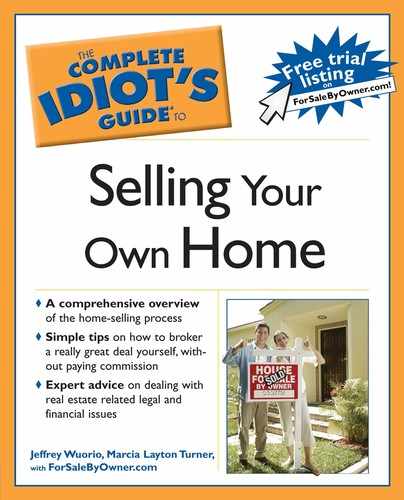Chapter 4
The Price Is Right
In This Chapter
• How to target the right price
• Putting a strategy into place
• Appraisers aren’t just for buyers
• Know market factors and other considerations
Bob Barker has, indeed, had it right all these years. No matter what you’re selling or buying, the price has to be right. Otherwise, either party involved in the transaction may simply walk away.
Given the price tag of many homes, this is particularly true with selling a home—and even more so when you’re doing it on your own. As is the case with so many other elements and issues, it’s up to you to perform the necessary legwork, research, and other steps to arrive at a price that’s both enticing to prospective buyers and reasonably profitable for you. In this chapter, we offer concrete steps and guidance on how to do precisely that.
Basic Market Research—First Steps to the Right Price
There’s no way around it—setting the right asking price for your home is the first step to a successful FSBO. If your price is too high, you’ll only discourage potential buyers. And that can lead to one of the least desirable after effects—the home that just languishes there, unloved and unwanted.
The other side of the coin is no more appealing. Here, you price your home too low. You may sell it quicker than you expected—and, on the surface, that can be great—only to discover later that you merely shortchanged yourself. If profit lost is worth the speed, fine. But as often as not, sellers kick themselves for not getting top dollar for their property.

Selling Smarts
Don’t overlook the importance of seeing other homes for yourself. Visit open houses and compare those properties and their asking prices with your own home. Note specific features and how they stack up against the ones in your home.
One of the reasons it can be so challenging to find just the right price for your home is that there are so many factors involved in the process. Some of them are rather straightforward, including the size of the house, number of bedrooms and other amenities, condition of the property, location, and other factors. Some are a bit more unpredictable, including local market conditions, the time of year, prevailing interest rates, and others which, boiled down, really have no direct connection to your home at all. But they can still affect what asking price works best.
Resources—Online and Elsewhere
Another powerful factor that dictates what price works and what doesn’t is the price of other homes in your local market—more specifically, other homes that have recently sold. To get a sense of what other homes have gone for, it’s necessary to perform a comparative market analysis. A comparative market analysis estimates the value of your property based on recent sales prices of comparable pieces of property.
Doing a comparative market analysis the old fashioned way—without an agent, as we mention in Chapter 3—takes a bit of legwork. First, you need to keep track of similar homes nearby that have been sold recently. Stick to homes that sold within the past six months. The closer their location to yours, the better. Then, contact your local assessor’s office and ask for the name of the owner of record. You then need to look up the applicable deed for the property. That should tell you the home’s most recent selling price.
It’s also possible to obtain comparative market analyses online. Sites include www.pricehomeonline.com and www.valuemyhouse.com (see the following figure), among others. The system usually requires you to enter information about your home and emails you back an estimated value (often, many such sites are connected to a real estate agency with an agent in tow, so be prepared to say something to the effect that you were just doing some preliminary research.)

Sales Snafu
One drawback to using your local government offices for a comparative market analysis is that you can only obtain sales prices. It doesn’t provide other details that may also impact your own strategy, such as special features, particularly attractive location and other elements that may impact price.

This page at valuemyhouse. com gives you an idea of the information you enter to obtain market information.
Another option that’s a good deal more comprehensive takes in features and details other than just the price of the home. This is known as a comparable.

Tools of the Trade
Comparables, which is short for “comparable properties” or “comps,” are pretty much what the term implies. These are homes that have recently been sold and are very much like yours in terms of size, location, and features. In effect, they set the pricing parameters for your home by having preceded you in the marketplace.
It really makes sense. All other things being equal, your home’s asking price is closely tied with other similar properties that have recently been sold. The added advantage to a comparable versus a comparative market analysis is that it’s just not a matter of price—individual features and specifics are also examined as well.
What are you looking for in a comparable home? Among other issues are the following: square footage, age of the home, condition of the home, style (cape, ranch, and so forth), number of bedrooms and bathrooms, property size, special features (pool, central air, and the like), landscaping, location (proximity to shopping, recreation, and school district, for example).
Thanks to the Internet, going online greatly streamlines the necessary steps to obtaining comprehensive comparable information. For instance, Forsalebyowner.com provides a service that automates comparables research. Ranging in price from $9.90 and up, homeowners can obtain information about comparable sales in the area, including sales trends, demographics, and other information pertaining to target price research.

Selling Smarts
Other websites that offer information on recent comparable sales and other information that can help identify a suitable asking price include www.domania.com. and www.homeradar.com.
No matter the method you choose to get comparables in your area, it’s helpful to draw up a checklist of features and other relevant information to make side-by-side comparisons as easy and useful as possible. To give you an idea of format and the sort of information that’s important to include, here’s a sample comparables report from Forsalebyowner.com that provides an overview of some elements to consider.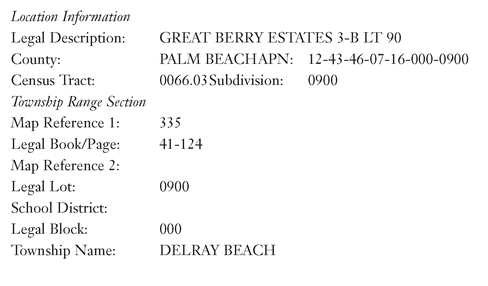
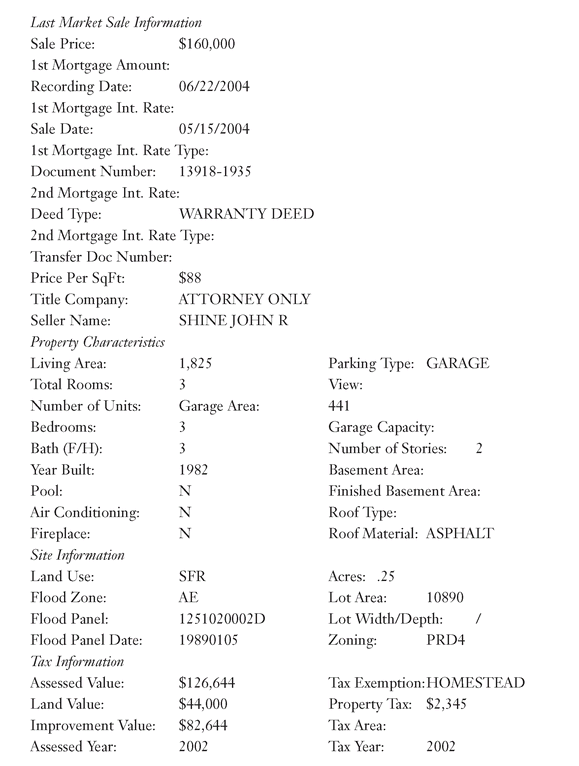


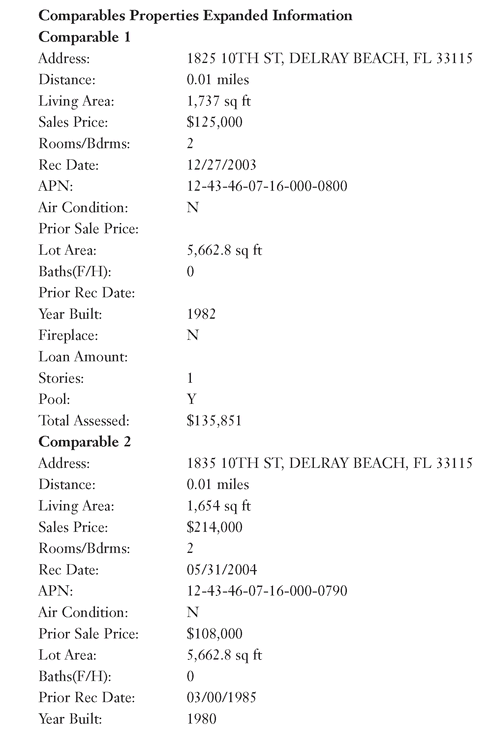
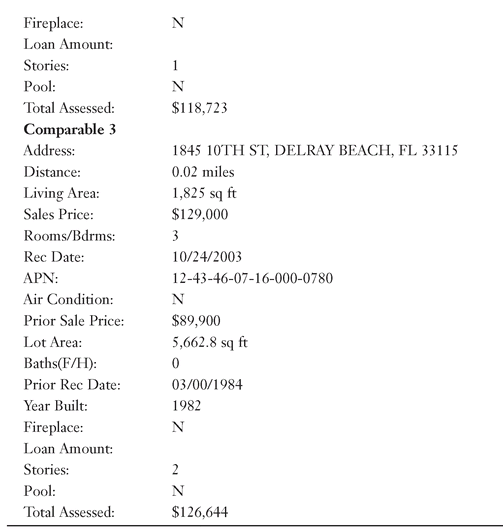
Total sales price is only one useful tool in setting the price of your home. Another way to use comparables to calculate the price for your own home is to break each down into dollar per square foot. For instance, in the three comparable houses cited, the price per square foot would break down as follows:
• Comparable Number One: $71.96 per square foot.
• Comparable Number Two: $129.38 per square foot.
• Comparable Number Three: $70.68 per square foot.
As you can see, there’s quite a bit of difference between the first and third homes and the second. That suggests something that may make the second home irrelevant to setting the price of your own home. Maybe there was one specific feature that a buyer simply couldn’t live without or some other unusual circumstance that drove the per square cost up so considerably. In any case, a difference of more than $50 per square foot is substantial enough to drop that from your calculations.
But the other two are close enough in per square foot value to suggest a possible target range for your home. And, the more comparables you can get that happen to fall within this general range, the greater your confidence that you’re zeroing in on a suitable price.
To calculate what sort of price your own home might command, simply take the average per square foot price of appropriate comparables and multiply by the square footage of your house. Let’s say you find a per square foot average of $71. Here are some sample prices based on different sized homes:
• 1,700 Square foot home—Estimated price—$120,700.
• 2,000 Square foot home—Estimated price—$142,000.
• 2,250 Square foot home—Estimated price—$159,750.
Strike a Balance
You’re likely getting the sense by now that pricing your home effectively isn’t just grabbing some number out of the thin air in hopes of getting the biggest payoff. Sure, everyone selling their home wants to pocket the biggest profit possible, but the overriding objective is to sell the home—hopefully, for the best price that it can command.

Tools of the Trade
Fair market value refers to the price that a buyer—any buyer—will agree to pay for your home. As we’ve seen—and will continue to discuss—there are a variety of factors that determine fair market value.
Of course, one of the advantages of selling your home yourself is that, because you don’t have to factor in the cost of a real estate agent’s commission to the price, you can afford to lower the asking price slightly, potentially making your home even more attractive to buyers.
To arrive at a suitable asking price, it’s essential to balance two considerations—pricing your home to sell and making a reasonable profit. This illustrates the importance of arriving at the fair market value for your home.
Because fair market value depends on a number of influences—some within your control, others outside of it—it’s important to make the most of those that you can influence. That’s why it’s so critical to consider both your need to sell your home and your desire to make the most money you can—as we cited in the beginning of this section. When setting the asking price, you need to keep in mind a price that will sell, not merely the price with the biggest payoff for you.
Here’s an example. Let’s say you’ve done a bit of market research and found several comparables in your area that sold for approximately $150,000. But, you think, your home has so much more going for it than those (what that happens to be, you’re not entirely sure, but your feeling is no less compelling.) So, you price your home at $160,000, determined to wring an extra 10 grand in profit from the sale.
Unfortunately, you see nothing more than a stream of prospective buyers who look around, smile politely, and hightail it out the door. Then, that highly unpleasant phenomenon occurs that we mentioned earlier in this chapter—the ever-dreaded house that languishes without selling.
And it languishes. And languishes some more. Troubled, you cut the price. Still more languishing. You drop the price a second time. Nothing. Finally, a third price cut does the trick. The only trouble is, you accept an offer for $143,000—some $7,000 less than other comparables commanded.
FSBO Facts
One of the first questions that buyers ask about a home is how long it has been on the market. That question comes with good reason—the longer a house goes unsold, the greater the leverage to the buyer, who can make a relatively low offer in hopes that the seller is discouraged or desperate enough to accept it. It’s also a form of leverage that grows more powerful with time. The longer a house stays on the market, the more likely it becomes that an owner will consider a lower offer.
The preceding illustration is a typical example of a home that was initially priced beyond its fair market value. In the end, the payoff was considerably less than it would have been had the owner simply put more stock in the influence of comparables.
Balancing the need to sell and a reasonable price also plays into how quickly you’ll likely be able to sell your home. In the prior example, not only was the eventual price disappointing, the home simply floundered on the market for a needlessly long period of time. Priced at fair market value, a home will not only provide a reasonable profit, chances are good that it will also turn over relatively quickly.
Strategic Planning
Finding the right price for your home isn’t merely a matter of compiling research and letting that speak for itself. Calculating just the right price at which point your home will sell both quickly and profitably mandates strategic planning. And that involves a mix of various issues and concerns, some of which are external, others derive from you and your understanding of the overall FSBO process.
Understand Your Marketplace
A central concern of effective strategic planning is coming to know your local real estate market as thoroughly as possible. In one sense, you’ve already started to get a handle on that by obtaining comparables sales information. This offers critical information about your local market—what sorts of homes are selling, at what price, how long the process is taking, and other elements that will affect your own sales efforts.

Tools of the Trade
As the names suggest, a buyer’s market is generally favorable to those shopping for a home, while a seller’s market favors those trying to sell a home they already own.
But it’s also important to understand your marketplace in a more global sense. Individual homes may sell more or less quickly depending on their features, but prevailing conditions also play a hand in how fast homes turn over. So, it’s important to study your overall market and, if need be, adjust your strategic planning accordingly.
Two terms you have likely heard in connection with real estate are a buyer’s market and a seller’s market. Just what causes these two rather global market trends varies considerably. For instance, a downturn in the local economy—say a major local employer shuts its doors or lays off scads of workers—can push a lot of homes onto the market quickly as people look to relocate. That creates a glut and prices fall, which results in a buyer’s market. There’s a lot to choose from and sellers are highly motivated.
By contrast, a seller’s market can develop if an area becomes particularly popular—the local economy takes an upturn or a city or area is mentioned in the media as being a particularly desirable place to live. As a result, homes are harder to find, buyers are fighting tooth and nail for those that are on the market, and prices go up.
Also know that there are variations within this seller/buyer seesaw. For instance, many markets are balanced, favoring neither buyer nor seller. In some cases, particular parts of a town or city may experience a boom or bust, making neighborhoods and sometimes individual streets hot and cold.
The reason this is important to you is that prevailing trends influence what you can expect to receive for your home and how quickly. Even an exceedingly desirable home in a down market may sit unsold for weeks and even months. By the same token, a home that’s nothing to write home about (pardon the pun) may get snapped up if a seller’s market exists and there aren’t that many homes from which to choose.
That, in turn, influences the sort of price you should consider. A solid home in a seller’s market may be in a position to be a bit more aggressive in starting out at a slightly larger asking price. On the other hand, if things are slow, adjusting your expectations downward a bit may be the most realistic course.

Selling Smarts
How do you know what sort of a market you’re in? Stay on top of the local news. Keep an eye on other homes for sale and how long it takes before the yard sign changes to “sold.” Call a few local real estate offices and try to establish a consensus on what their take is on the local market. If you know someone who just sold their home, ask them how it went.
Taking a FSBO Into Account When Setting Prices
One of the advantages we’ve been stressing about selling your home on your own is the substantial real estate agent commission you stand to save. And as we’ve pointed out, at a going rate of about 6 percent of the sale price, that can be quite a tidy sum.
But the absence of a commission proves advantageous in other ways. It can actually help you sell your home faster and at a greater profit. Why? Because you can afford to set your asking price lower than you would have had you used an agent while still coming out ahead in the end.
Here’s an example. Let’s say, after all your legwork with comparables, price per average square calculations, and the like, you figure your home can sell for $200,000. Drop an agent into the mix. At 6 percent commission, you pocket $188,000 ($12,000 lost in commission.)
But now let’s assume that you’re in a hurry to sell your home, so you set the price at $195,000—$5,000 less than the going average. A true bargain in sight, buyers beat your door down and the sale goes through quickly. And even though you set the price $5,000 lower than you possibly could have, your profit is $7,000 greater.
So in its own way, a FSBO unto itself can go against the temptation to be too greedy. Instead, trim your price just a bit, sell your home faster, and haul your extra profit straight to the bank.

Selling Smarts
One way to take a FSBO into account when setting the price is to split the commission savings between yourself and the buyer. For instance, in the previous example, your home can sell for $200,000, but you would only get $188,000 after an agent’s 6% take. Consider setting your home’s selling price at 194,000. This is the market price minus half the agent’s commission, or 3%. You set up a bargain for buyers, but one that still earns you a handsome profit.
Appraising the Appraiser—What They Do, How to Choose
Up until now, we’re assuming that, like so many FSBOs, you’re a real self-sufficient do-it-yourselfer. Terrific! Every task you can handle on your own not only saves you money, it also furthers your understanding and overall appreciation of the FSBO experience.
But determining the absolute best price for your FSBO may be one of those instances where it’s the better part of valor to defer to a professional. That means it may be well worth your time and your pocketbook to give some thought to hiring an appraiser.
As you can see, an appraiser does what you would do in establishing comparably priced homes. Why bother to use an appraiser? It’s a matter of objectivity and substance. A professional appraisal provides comprehensive evidence to substantiate the asking price for your home. Rather than simply taking your word for it, a professional appraisal provides prospective buyers with clear-cut information that shows the asking price is, indeed, fair.

Tools of the Trade
An appraiser is professionally trained to estimate what your home is worth. An appraiser goes through your home in some detail, noting various features and the condition of the home, then compares your property with others of similar features.
Another plus to using an appraiser is that he or she will be trained to take differences between homes into account and make necessary adjustments in their respective values. That means they look at size, location, condition of the home, special features and other elements and calculate respective values depending on how one home may differ from another.
If the idea of using an appraiser seems to make sense, be sure to do a bit of shopping and research. Ask them about the training and other forms of necessary certification. When asking about experience, be sure to have them specify how much local experience they have, as markets differ enough to make experience in some other part of the country somewhat irrelevant. Of course, ask how much they charge—expect to pay in the neighborhood of several hundred dollars for a thorough home appraisal.
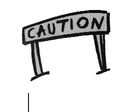
Sales Snafu
Currently, no uniform federal regulations exist for licensing and certifying appraisers. That’s up to the individual states. There are, however, several professional groups (listed at the end of this chapter) that enforce certain standards for training and practice. When looking for an appraiser, be sure to ask for referrals from your local bank or government housing agency. Chances are excellent they’ve worked with several in the past they would recommend with confidence.
Other Pricing Considerations
You have several final issues to consider in setting the price of your FSBO. They are not as central as some of the topics we’ve covered in earlier sections of this chapter, but they can matter, often in quite a substantial way.
Every Dollar Matters
Have you ever noticed that most retail stores price items in what, on the surface, may seem like a needlessly complicated manner? For instance, a DVD player isn’t $100; it’s $99.50. Likewise, the DVD that goes into that machine isn’t $10; it goes for $9.95.
If you break things down, the differences in those prices are rather modest—just a matter of a few cents. But, the way a prospective buyer sees those prices is decidedly different. Even though $100 and $99.50 is only a difference of fifty cents,
from a psychological standpoint, it’s substantial. By buying a DVD player for $99.50, you’re not cracking the $100 mark. And, substantial or not, buyers find that comforting and appealing.

Selling Smarts
Pricing your home in this fashion can also matter if you list your home on an online listing service. Because many buyers specify a price range when beginning their search, dropping your price just below a certain level can tuck it into more moderately priced searches.
Consider that same approach in pricing your home. If you think you can get $300,000 for your property, price it at $299,000. That’s only a difference of $1000, but to a prospective buyer who has it in her head not to exceed $300,000 for a home, that relatively modest difference can, in the end, make all the difference in what you get for your home and how quickly you’re able to finalize a sale.
A Sweeter Transaction
Unto itself, many sellers might assume the asking price is the only pertinent financial information that goes into setting the right price. But there are other elements having to do with the overall sale that may, in fact, boost the asking price that works for you.
• First, consider how quickly you’re willing to close on the deal. If you make it clear to prospective buyers that you’re willing to move things along as fast as they need them to go, that can attract buyers who are in a particular rush to close a deal and move in. And that can mean a slightly greater asking price in return.
• Almost everyone these days finances a home purchase. Many of those buyers—often first timers and others of more limited financial means—find it a challenge to obtain conventional financing. If you’re willing to offer even a modest amount of owner financing, that, too, may command a slightly larger asking price than what you would ask for under more usual circumstances. More about this in Chapter 14.
• With regard to first time homebuyers, anything you can provide in the way of more generous terms can mandate a larger asking price. For instance, a rent-to-own option offers buyers with modest resources an opportunity to get their foot in the home buying door—and, you as the seller, with an opportunity to trade that generosity for a slightly larger price tag. This, too, is addressed in Chapter 14.
The bottom line here is, the broader the financial options you’re willing to consider, the greater number of buyers you’ll likely attract. Not only might that result in a faster, less hassle-ridden sale, it may increase your profit margin at the same time.
Other Online Pricing Resources
We’ve already mentioned a few, but here are a few additional websites that will help you research and determine the absolute best price for your FSBO:
• Quicken Loans (www.quickenloans.com/refinance/refinance_calculators/home_value_calculator.html?lid=772). This is a quick and easy way to get a ball-park figure of what your home might be worth.
• For SaleByOwner.com (www.ForSalebyOwner.com/homesales/prices). This displays a list of recent sold homes in a specified area. Going to www.ForSalebyOwner.com/Appraisals takes this information one step further and offers an estimated value of your home.
There are also a number of professional appraisers’ organizations. The following are worth having a look at:
• The American Society of Appraisers (www.appraisers.org)
• The Appraisal Foundation (www.appraisalfoundation.org)
• The Appraisal Institute (www.appraisalinstitute.org)
The Least You Need to Know
• Focus on pricing your home to sell, not merely for the biggest profit possible.
• A comparative market analysis is one way to get a quick estimate of what a suitable selling price for your home might be.
• Comparables—which can be obtained online—offer a comprehensive comparison of homes similar to yours that have recently sold. They offer a more specific idea of a target price.
• Remember, because you’re selling your home without having to pay a commission, you can price your home lower than you would have with an agent and still make a good profit.
• Consider hiring an appraiser to identify comparable homes. An appraiser’s report is essential in justifying the asking price for your home.
• Be open to financing options for buyers. You may command a slightly larger price for your home if you do.
..................Content has been hidden....................
You can't read the all page of ebook, please click here login for view all page.
